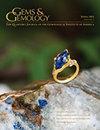Vietnam: Shell Nuclei, Pearl Hatcheries, and Pearl Farming
IF 1.6
3区 地球科学
Q2 MINERALOGY
引用次数: 1
Abstract
GEMS & GEMOLOGY FALL 2020 V is a land of great diversity and beauty. From the hustle and bustle of Ho Chi Minh City to the beauty of Hạ Long Bay and Hoi An (both UNESCO World Heritage Sites), there are innumerable places of interest. Economically, Vietnam is beginning to see significant investment from a wide range of businesses, domestic and foreign. While still dependent on agriculture, the country is emerging as a major player in the electronics and oil/gas industries, among others. These factors, together with a robust tourism industry, are resulting in an expanding population with greater prosperity than ever before. Jewelry, including pearl jewelry, ranks high on the list of luxury items, as there is a significant range of price points at which disposable wealth can be spent. From the costume jewelry sector to high-end offerings, there is something to suit all tastes. While cultured pearls, accounting for 99.9% of the market since the early 1900s, do not usually fall into the higher-end bracket, there remains a healthy demand from consumers (Shor, 2007; Heebner, 2015). The choice of bead cultured pearls in the marketplace is also diverse. Consumers may choose from the usual imported gray to black Tahitian bead cultured pearls, “golden” bead cultured pearls from the Philippines or Indonesia, and bead cultured pearls produced in China. Hạ Long Bay (figures 1 and 2) in northern Vietnam is where most pearl farms, producing predominantly “akoya” (Pinctada fucata martensii) pearls, may be found. These farms are a mix of independent operations and joint ventures with the Vietnamese government. A prime example of the latter is Spica, a Vietnamese-Japanese joint venture that has produced bead cultured pearls for more than a decade. Some farming activity is also found in the waters off southern Vietnam at Nha Trang, as will be seen later, and Phu Quoc (Strack, 2006). Vietnam has produced saltwater cultured pearls commercially since the 1990s. However, the first attempts reportedly began in the 1960s (Strack, 2006). Today, based on the 300–400 kg production from the two farms visited in this report, the country is estimated to produce approximately 2,000 kg per annum. The majority of the production is akoya, with a smaller quantity of Pinctada maxima, and much of the production is currently exported to China, Japan, India, and the United Sates. When the harvests are good, the quality tends to be higher, but the opposite also holds true.越南:贝壳核,珍珠孵化场和珍珠养殖
2020年秋季是一片充满多样性和美丽的土地。从熙熙攘攘的胡志明市到美丽的赫隆湾和会安(都是联合国教科文组织世界遗产),这里有无数的名胜古迹。在经济上,越南开始看到来自各种国内外企业的大量投资。虽然仍然依赖农业,但该国正在成为电子和石油/天然气工业等领域的主要参与者。这些因素,加上强劲的旅游业,导致人口增长,比以往任何时候都更加繁荣。珠宝,包括珍珠首饰,在奢侈品榜单上排名靠前,因为可支配财富的消费价格范围很大。从人造珠宝到高端产品,总有适合所有人口味的产品。虽然自20世纪初以来占市场99.9%的养殖珍珠通常不属于高端市场,但消费者仍然有健康的需求(Shor, 2007;Heebner, 2015)。市场上养殖珍珠的选择也多种多样。消费者可以选择通常进口的灰色到黑色塔希提珠养殖珍珠,来自菲律宾或印度尼西亚的“金色”珠养殖珍珠,以及中国生产的珠养殖珍珠。越南北部的hnhong Bay(图1和2)是大多数珍珠养殖场的所在地,主要生产“akoya”珍珠。这些农场既有独立经营的,也有与越南政府合资经营的。后者的一个典型例子是越南-日本合资企业Spica,该公司生产珍珠养殖珍珠已有十多年的历史。在越南南部的芽庄(Nha Trang)和富国(Phu Quoc)附近海域也发现了一些农业活动(Strack, 2006)。自20世纪90年代以来,越南已经开始商业化生产海水养殖珍珠。然而,据报道,第一次尝试始于20世纪60年代(Strack, 2006)。今天,根据本报告访问的两个农场的300-400公斤的产量,该国估计每年生产约2,000公斤。生产的大部分是akoya,少量的Pinctada maxima,大部分产品目前出口到中国,日本,印度和美国。收成好的时候,质量往往更高,反之亦然。
本文章由计算机程序翻译,如有差异,请以英文原文为准。
求助全文
约1分钟内获得全文
求助全文
来源期刊

Gems & Gemology
地学-矿物学
CiteScore
2.90
自引率
19.20%
发文量
10
期刊介绍:
G&G publishes original articles on gem materials and research in gemology and related fields. Manuscript topics include, but are not limited to:
Laboratory or field research;
Comprehensive reviews of important topics in the field;
Synthetics, imitations, and treatments;
Trade issues;
Recent discoveries or developments in gemology and related fields (e.g., new instruments or identification techniques, gem minerals for the collector, and lapidary techniques);
Descriptions of notable gem materials and localities;
Jewelry manufacturing arts, historical jewelry, and museum exhibits.
 求助内容:
求助内容: 应助结果提醒方式:
应助结果提醒方式:


